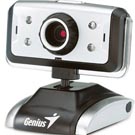Choosing a webcam: Resolution is key
Hanover, Germany - Images rule the digital media world - even those from your own computer  desk. A headset for making telephone calls and chatting has become a nearly standard part of every PC's peripherals - and for many people a webcam is essential, too.
desk. A headset for making telephone calls and chatting has become a nearly standard part of every PC's peripherals - and for many people a webcam is essential, too.
"Video telephony is reality," says Georg Wilde, press spokesman for Philips. And that applies not just for all parents whose children have gone off to college or business travelers looking to say a quick "hello" to their families from afar.
"Companies are now using webcams for teleconferences, too," says Ulrich Hilgefort from Hanover-based c't magazine. Employees who travel a lot are particularly good candidates for webcams to keep them in contact with their colleagues. Yet, nowadays webcams can also be used for more than just traditional internet-based video conferences, reports Dirk Sturny from hardware maker Logitech.
A program called "eTandem" at the Ruhr University of Bochum, for example, uses the technology to connect students studying foreign languages with native speakers from around the world. "More companies are now also stipulating in their job postings that candidates should apply using webcam or video," Sturny says. Online speed dating would also be impossible without the little cameras.
Webcams are relatively simple devices. They are easy to install and can be used by almost any computer with a broadband internet connection. Current webcams achieve resolutions of up to two megapixels. The key benchmark is the optical resolution. Manufacturers often tout a resolution value known as the interpolated value - even if the number is not particularly helpful in determining a camera's quality.
Users shouldn't expect all too much from their webcams: "A webcam is neither a DV camcorder or a digital photo camera - it's playing in a different league," Hilgefort says. Many cameras also include an integrated microphone - although the quality is often less than ideal. "If you want to chat with someone, a headset is a better choice," says Hilgefort.
A good webcam costs around 50 dollars, Hilgefort says. Expert tests have shown that name-brand devices tend to perform much better than no-name models. The budget models often are simply not sensitive enough, with strong noise effects when the lighting is poor - which translates into poor image quality. "The best cameras still provide good images even if the light strengths is under ten lux - which corresponds to the light of ten candles from one meter distance," Hilgefort says.
Sturny recommends buying only devices with glass lenses. That provides better transfer of the light to the camera's sensor. "Plastic lenses often cause distortions," he says. Some of the latest webcams also come with an autofocus system included to adjust the sharpness when the subject moves. (dpa)